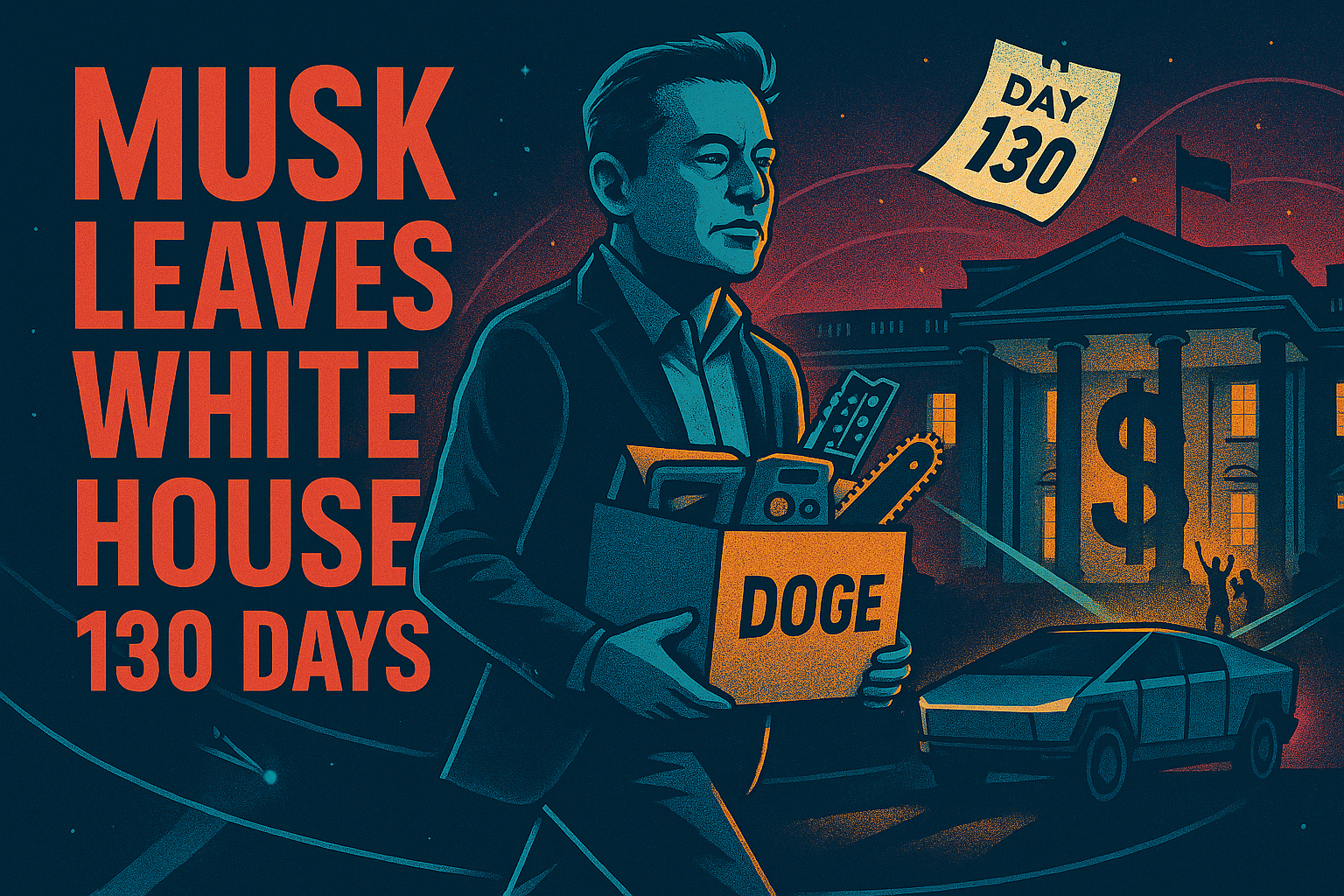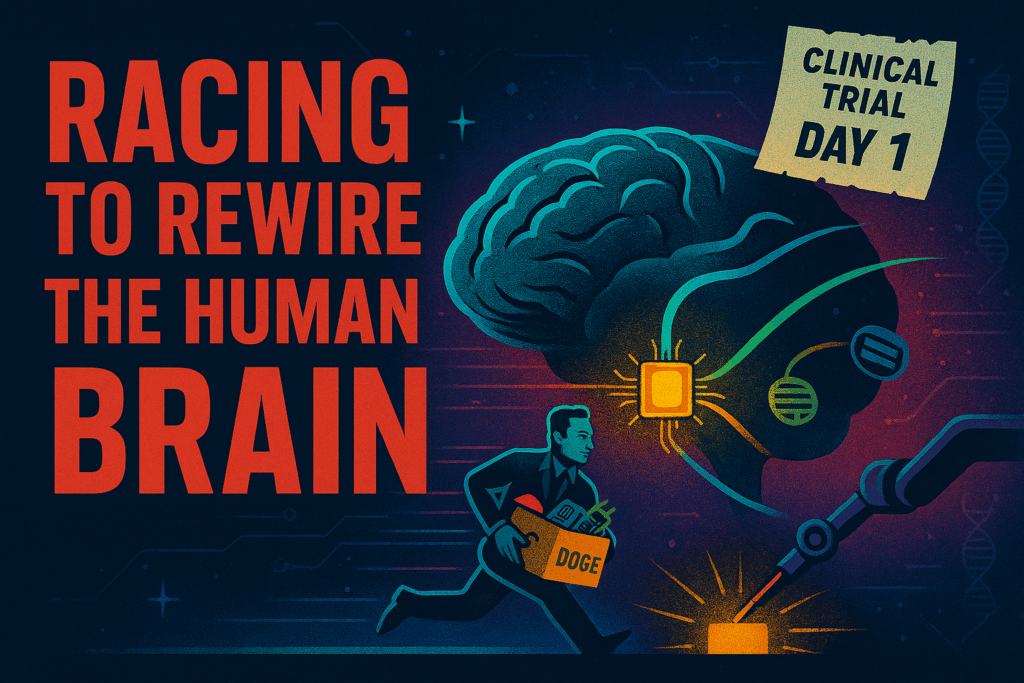Elon Musk officially departed his role as a special government employee leading the Department of Government Efficiency (DOGE) on May 28, 2025, Al JazeeraNBC News ending an unprecedented experiment in tech-government integration that achieved significant federal workforce cuts but ultimately foundered on policy disagreements with President Trump. Reuters +5 The immediate trigger was Musk’s public criticism of Trump’s spending bill, which he said “increases the budget deficit” and “undermines” DOGE’s mission Al Jazeera +3 – comments that deeply upset senior White House officials including Deputy Chief of Staff Stephen Miller. Reuters +5 While the White House characterized the departure as a planned conclusion of Musk’s 130-day temporary appointment, Fox News multiple sources indicate growing tensions over spending policy, Cabinet conflicts, and mounting business pressures at Tesla accelerated his exit. Reuters The departure marks a dramatic conclusion to Musk’s second attempt at serving in a Trump administration, having previously resigned from advisory councils in 2017 over climate policy disagreements. The FulcrumWikipedia
From climate critic to MAGA champion: Musk’s political transformation
Musk’s journey from Trump critic to close ally represents one of the most dramatic political transformations in recent American history. After serving briefly on Trump’s advisory councils in 2017, Musk resigned in protest when Trump withdrew from the Paris Climate Agreement, stating bluntly that “climate change is real” and the decision was “not good for America or the world.” Reuters +4 The relationship remained distant through Trump’s first term and deteriorated further during the Biden years, particularly after Biden excluded Tesla from a high-profile EV summit in August 2021 despite the company representing 74% of US electric vehicle sales. Rsbnetwork This snub, driven by White House concerns about angering the United Auto Workers over Tesla’s non-union status, marked a turning point in Musk’s political evolution. Tesla Mag
The transformation accelerated during the COVID-19 pandemic when Musk opposed California’s lockdowns affecting Tesla factories, calling the restrictions “fascist” and developing his critique of what he termed the “woke mind virus.” NPRLiterary Hub Personal factors played a crucial role – Musk has cited his estrangement from his transgender daughter Vivian Jenna Wilson as a key motivation, claiming she was “killed by the woke mind virus.” NPRLiterary Hub By 2024, this rightward shift culminated in Musk’s immediate endorsement of Trump following the July 13 assassination attempt in Butler, Pennsylvania, followed by record-breaking donations totaling $288-290 million The Washington Post to Trump and Republican candidates through various PACs. Wikipedia +6
The reconciliation reached its apex when Trump appointed Musk to lead DOGE as a special government employee on January 20, 2025, Wikipedia granting him unprecedented authority to reshape the federal government while maintaining control of companies with billions in government contracts. 6abcReuters
The chainsaw approach: DOGE’s aggressive restructuring
During his 130-day tenure, Musk brought Silicon Valley’s “move fast and break things” mentality directly to Washington, wielding a red chainsaw at the Conservative Political Action Conference as a symbol of his bureaucracy-cutting mission. ReutersNBC News DOGE claimed to have eliminated approximately 260,000 federal positions – about 12% of the civilian workforce – through a combination of mass terminations, buyouts, and entire agency shutdowns. Reuters The initiative originally targeted $2 trillion in savings before being scaled back to $1 trillion, then ultimately claiming $175 billion in cuts, The Washington PostBoston though a Washington Post analysis found that DOGE had overstated savings by at least $55 billion. The Washington Post +3
Musk’s methods proved as controversial as they were dramatic. He demanded federal employees respond to weekend emails or face termination, attempted to shut down entire agencies including USAID, and gained access to Treasury Department payment systems containing Americans’ Social Security numbers and banking data. CNN +2 His confrontational style led to heated exchanges with Cabinet members, including a “West Wing shouting match” with Treasury Secretary Scott Bessent and clashes with Secretary of State Marco Rubio over USAID’s dismantling. The Washington Post +4 Trump ultimately sided with his Cabinet secretaries, reminding a meeting that department heads, not Musk, controlled staffing decisions. PBSReuters
The aggressive approach sparked nationwide protests, with Tesla dealerships vandalized and vehicles burned. Axios +2 Fourteen states filed lawsuits challenging Musk’s authority, while federal employee unions mobilized against what they called “government by oligarch.” The Washington Post NPR investigations revealed potential data security breaches at the National Labor Relations Board, adding to concerns about DOGE’s methods. NPR
Breaking point: The spending bill that broke the alliance
The relationship between Trump and Musk reached its breaking point over fiscal policy, specifically Trump’s signature “One Big Beautiful Bill” – a massive Republican spending package that Musk viewed as contradicting DOGE’s cost-cutting mission. ABC News +3 In a May 27 CBS News interview, Musk delivered his most direct criticism of Trump since taking office: “I was disappointed to see the massive spending bill, frankly, which increases the budget deficit, not just decreases it, and undermines the work that the DOGE team is doing. I think a bill can be big or it can be beautiful, but I don’t know if it can be both.” Al Jazeera +7
These comments created an immediate crisis within the White House. Deputy Chief of Staff Stephen Miller was “particularly irked,” forcing the administration to call Republican senators to reassure them of Trump’s continued support for the legislation. Reuters The public disagreement violated an unspoken rule of the Trump White House – that criticism stays private – and accelerated discussions about Musk’s departure that had been circulating since April.
Beyond the spending dispute, Musk had increasingly clashed with Trump’s inner circle over trade policy, calling adviser Peter Navarro “truly a moron” and “dumber than a sack of bricks” while advocating for free trade zones that contradicted Trump’s protectionist agenda. ReutersThe Washington Post His support for H-1B visas for skilled workers also put him at odds with immigration hardliners. By late May, what began as a transformational partnership had devolved into a relationship where, according to Reuters sources, Musk’s departure was “decided at a senior staff level” without even a formal conversation between the two principals. Reuters
Market relief meets political backlash
The business impact of Musk’s departure was immediate and dramatic. Tesla stock surged 5.3% on news of his exit, partially reversing a year-to-date decline of approximately 30-45% that analysts had largely attributed to his polarizing political role. Fox Business +4 The company had reported a 71% profit plunge and 13% sales drop in the first quarter of 2025, with widespread protests and boycotts significantly impacting the brand. The Washington Post Wedbush analyst Dan Ives called the departure “music to the ears of Tesla shareholders,” reflecting investor relief that Musk could refocus on the struggling automaker. Proactiveinvestors
Political reactions split predictably along party lines, though with notable nuances. While Democratic leaders celebrated – with Rep. Greg Casar calling it “a win for working people” The Washington Post – Republicans showed more mixed responses. The Washington Post House Speaker Mike Johnson praised Musk’s DOGE achievements, CNBC but TIME magazine reported that “on Capitol Hill, there was one universal sentiment circulating among Republicans of all political stripes: Finally.” GOP aides privately expressed relief, viewing Musk as having become “a drag on their efforts to deliver on a conservative agenda.” Time
Public opinion had turned decisively against Musk’s government role, with 55% saying he had too much power according to Quinnipiac polling, while his personal approval rating dropped to 35%. Al JazeeraPoynter The Wisconsin Supreme Court race, where Musk spent $3.5 million supporting the losing Republican candidate, demonstrated his limited political influence despite massive spending. PBS +2 His transformation from innovative entrepreneur to political lightning rod had alienated both Tesla customers and political moderates.
A new model for tech-government integration – or corruption?
Musk’s tenure as a government efficiency czar while simultaneously running companies with $13 billion in federal contracts over five years created unprecedented conflicts of interest that may reshape how Americans view the intersection of private wealth and public power. The Washington Post +2 During his time in government, SpaceX secured $5.92 billion in new Space Force contracts, while multiple investigations into his companies were halted or slowed. Newsweek +2 The arrangement allowed Musk to advocate for dismantling agencies that regulated his businesses while embedded DOGE personnel influenced NASA decisions affecting SpaceX contracts.
The precedent has profound implications for American governance. Tom Schatz of Citizens Against Government Waste suggested that future tech leaders might seek similar arrangements, normalizing what critics called “government by oligarch.” Reuters The fact that X platform’s value plummeted from $44 billion to an estimated $9 billion during this period, Wikipedia while SpaceX’s valuation soared to $350 billion, illustrates how government influence can create wildly divergent outcomes across a billionaire’s portfolio. NPR
Despite his departure, Musk announced plans to maintain a small White House office and spend “one to two days per week on government matters for as long as the president would like.” The Daily Beast +3 This continued involvement, albeit reduced, suggests the Trump-Musk alliance may persist in modified form, with the tech billionaire serving as an outside adviser rather than a disruptive insider.
Conclusion
Elon Musk’s 130-day experiment in bringing Silicon Valley disruption to Washington achieved significant workforce reductions but ultimately demonstrated the limits of treating democratic governance like a tech startup. Reuters His departure following public criticism of Trump’s spending priorities revealed that even the world’s richest person cannot indefinitely maintain influence when core policy visions diverge. Reuters The legacy of this unprecedented arrangement – a billionaire with massive conflicts of interest wielding direct government power – will likely prompt future administrations to establish clearer boundaries between private business interests and public service.
While DOGE will continue under Cabinet leadership, Musk’s exit removes both a lightning rod for criticism and a powerful advocate for radical government restructuring. CNNReuters The episode illuminates fundamental tensions in American democracy: between efficiency and accountability, between private sector innovation and public sector stability, and between the concentration of wealth and the diffusion of democratic power. As 人工智慧 and space exploration increasingly shape national competitiveness, the question of how to harness entrepreneurial talent without compromising democratic governance remains urgently unresolved. Musk’s turbulent tenure offers a cautionary tale about the perils of unchecked private influence in public affairs, even as it demonstrated the potential for rapid government transformation when political will aligns with disruptive vision.







![Meta's $300 million gamble reshapes the AI talent wars Meta has launched the most aggressive talent acquisition campaign in technology history, offering individual compensation packages up to $300 million over four years to elite AI researchers. CNBC +7 This unprecedented strategy, coupled with $60-65 billion in infrastructure investments for 2025, represents Mark Zuckerberg's all-in bet to transform Meta from an AI follower into the leader in the race toward superintelligence. Data Center Dynamics +5 The campaign has successfully recruited dozens of top researchers from OpenAI, Google DeepMind, and Apple, while fundamentally disrupting compensation norms across the entire AI industry and raising critical questions about talent concentration and the future of AI development. CNBC +8 The $300 million figure decoded: Individual packages, not aggregate spending The widely reported "$300 million AI brain drain" figure represents individual compensation packages for elite AI researchers over four-year periods, not Meta's total spending on talent acquisition. Gizmodo +3 According to Fortune's July 2025 reporting, "Top-tier AI researchers at Meta are reportedly being offered total compensation packages of up to $300 million over four years, with some initial year earnings exceeding $100 million." Fortune Yahoo Finance These packages primarily consist of restricted stock units (RSUs) with immediate vesting, rather than traditional signing bonuses, as Meta CTO Andrew Bosworth clarified: "the actual terms of the offer wasn't a sign-on bonus. It's all these different things." CNBC +2 The compensation structure includes base salaries up to $480,000 for software engineers and $440,000 for research engineers, Fortune supplemented by massive equity grants and performance bonuses. Fortune SmythOS Specific examples include Ruoming Pang from Apple receiving $200+ million over several years Fortune and Alexandr Wang from Scale AI receiving $100+ million as part of Meta's $14.3 billion investment in Scale AI. Fortune +3 OpenAI CEO Sam Altman confirmed these figures on the "Uncapped" podcast, stating Meta made "giant offers to a lot of people on our team, you know, like $100 million signing bonuses, more than that (in) compensation per year." CNBC +6 This compensation strategy emerged after Meta's Llama 4 model underperformed expectations in April 2025, prompting Zuckerberg to take personal control of recruitment. CNBC +3 The CEO maintains a "literal list" of 50-100 elite AI professionals he's targeting, making direct phone calls to recruit them. Fortune +5 While not every hire receives nine-figure packages—typical offers range from $10-18 million annually—the peak compensation levels have redefined industry standards and forced competitors to dramatically increase their retention spending. TechCrunch Meta raids the AI elite: Key acquisitions from competitors Meta's talent acquisition campaign has systematically targeted the architects of competitors' most successful AI models, with particular focus on researchers with expertise in reasoning models, multimodal AI, and foundation model training. SmythOS Fortune The company has successfully recruited 11+ researchers from OpenAI, including several co-creators of ChatGPT and the o-series reasoning models. South China Morning Post +4 Notable acquisitions include Shengjia Zhao, named Chief Scientist of Meta Superintelligence Labs in July 2025, who co-created ChatGPT, GPT-4, and all mini models; CNN Trapit Bansal, a key contributor to OpenAI's o1 reasoning model who pioneered reinforcement learning approaches; TechCrunch TechCrunch and Hongyu Ren, co-creator of GPT-4o, o1-mini, and o3. CNBC +2 From Google DeepMind, Meta secured Jack Rae, the pre-training tech lead for Gemini who also led development of Gopher and Chinchilla; Pei Sun, who led post-training, coding, and reasoning for Gemini after creating Waymo's perception models; Fortune CNBC and multiple other Gemini contributors. CNBC Silicon UK The Apple raid centered on Ruoming Pang, head of Apple's AI foundation models team who led Apple Intelligence development, along with three senior team members including distinguished engineer Tom Gunter. MacDailyNews +4 These acquisitions follow a clear strategic pattern: Meta is targeting researchers with proven expertise in areas where it has fallen behind, particularly reasoning models and multimodal AI. SmythOS The recruits often move as cohesive teams—for instance, the OpenAI Zurich office researchers Lucas Beyer, Alexander Kolesnikov, and Xiaohua Zhai all joined Meta together. TechCrunch TechCrunch This team-based approach accelerates Meta's ability to replicate successful research methodologies while disrupting competitors' ongoing projects. The talent flow has created significant disruption at source companies. OpenAI's Chief Research Officer Mark Chen described the exodus in an internal memo: "I feel a visceral feeling right now, as if someone has broken into our home and stolen something." Yahoo! +2 Apple's AI strategy faced major setbacks after losing its foundation models leadership, forcing a reorganization under Craig Federighi and Mike Rockwell. MacRumors Superintelligence ambitions drive massive infrastructure buildout Meta's creation of the Meta Superintelligence Labs (MSL) in June 2025 represents a fundamental reorganization of its AI efforts under unified leadership. Led by Alexandr Wang as Chief AI Officer and Nat Friedman heading AI products and applied research, MSL consolidates all AI research with the explicit goal of achieving "personal superintelligence for everyone." CNBC +2 Zuckerberg's internal memo declared: "As the pace of AI progress accelerates, developing superintelligence is coming into sight. I believe this will be the beginning of a new era for humanity." CNBC +2 The infrastructure investments supporting this ambition dwarf anything previously attempted in corporate AI research. Meta committed $60-65 billion for 2025 alone, representing a 50% increase from 2024, with plans for "hundreds of billions of dollars" in coming years. Data Center Dynamics +7 The company is constructing two revolutionary data centers that abandon traditional designs for speed-focused "tent" infrastructure. The Prometheus Cluster in Ohio will provide 1 gigawatt of capacity by 2026, featuring on-site natural gas generation through two 200MW plants to bypass grid limitations. The Hyperion Cluster in Louisiana represents an even more ambitious undertaking: a 2GW facility scaling to 5GW, covering an area "the size of most of Manhattan" with a $10 billion investment on 2,250 acres. Opportunity Louisiana +5 Meta's technical infrastructure includes 1.3+ million GPUs targeted by end of 2025, utilizing prefabricated power and cooling modules for rapid deployment and sophisticated workload management to maximize utilization. PYMNTS +3 The company has shifted its research focus from traditional AGI to what Chief AI Scientist Yann LeCun calls "Advanced Machine Intelligence" (AMI), arguing that human intelligence is specialized rather than generalized. Columbia Engineering AI Business Current research priorities span computer vision (Perception Encoder, Meta Locate 3D), foundation models (continued Llama development despite setbacks), world models for predicting action outcomes, and collaborative AI for multi-agent reasoning. Meta meta The Llama 4 "Behemoth" model's failure—attributed to chunked attention creating blind spots and economically unviable inference—led to a strategic pivot toward smaller, more efficient variants while the new superintelligence team addresses fundamental research gaps. CNBC +4 The talent war escalates: Compensation packages reach athlete-level extremes The AI talent war has created compensation dynamics unprecedented in technology history, with packages now exceeding those of professional athletes and Wall Street executives. Meta's aggressive offers have forced industry-wide salary inflation, with typical AI researcher packages at major labs now ranging from $2-10 million annually. Ainvest +4 OpenAI responded to defections by jumping stock compensation 5x to $4.4 billion company-wide, offering $2+ million retention bonuses with one-year commitments and $20+ million equity deals to prevent key departures. Fortune +3 Despite Meta's financial firepower, retention data reveals that money alone doesn't guarantee loyalty. Meta maintains only a 64% retention rate, the lowest among major AI labs, while experiencing 4.3% annual attrition to competitors. SmythOS The Register In contrast, Anthropic achieves an 80% retention rate with more modest compensation ($311K-$643K range) by emphasizing mission-driven culture and researcher autonomy. The Register +6 The data shows an 8:1 ratio of OpenAI departures favoring Anthropic over the reverse, suggesting that purpose and product quality matter as much as pay. signalfire Analytics India Magazine The compensation arms race extends beyond individual packages to strategic "acqui-hires." Google executed a $2 billion deal to bring back Noam Shazeer and the Character.AI team, while Microsoft absorbed most of Inflection AI for $650 million. Fortune Fortune These deals allow companies to acquire entire teams while potentially avoiding regulatory scrutiny of traditional acquisitions. Geographic concentration intensifies the competition, with 65% of AI engineers located in San Francisco and New York. signalfire However, emerging hubs like Miami (+12% AI roles) and San Diego (+7% Big Tech roles) are beginning to attract talent with compensation at 83-90% of Bay Area levels. Fortune The elite talent pool remains extremely constrained, with experts estimating only 2,000 people worldwide capable of frontier AI research, driving the extreme premiums for proven expertise. The Register Fortune Industry experts divided on Meta's bold strategy Industry analysis reveals deep divisions about Meta's approach and its implications for AI development. SemiAnalysis characterizes the compensation packages as making "top athlete pay look like chump change," with typical offers of "$200M to $300M per researcher for 4 years" representing "100x that of their peers." CFRA analyst Angelo Zino views the acquisitions as necessary long-term investments: "You need those people on board now and to invest aggressively to be ready for that phase of generative AI development." Yahoo! CNBC Academic researchers express concern about the broader implications. MIT's Neil Thompson and Nur Ahmed warn that by 2020, "nearly 70% of AI Ph.D. holders were recruited by industry, up from only 21% in 2004," creating a troubling brain drain that "leaves fewer academic researchers to train the next generation." MIT Sloan Brookings They argue this concentration could "push to the sidelines work that's in the public interest but not particularly profitable," including research on AI bias, equity, and public health applications. MIT Sloan Competitors have responded with varying strategies. Google relies on personal intervention from leadership, with co-founder Sergey Brin "personally calling an employee and offering them a pay rise to stay," while maintaining advantages in computing power and proprietary chips. Fortune +2 Microsoft has "tied its AI fate to OpenAI" while building in-house capabilities, even reviving the Three Mile Island nuclear plant to power AI operations. PYMNTS OpenAI faces the most direct impact, with Sam Altman criticizing Meta's approach as "distasteful" and arguing that "missionaries will beat mercenaries." CNBC +6 The venture capital community sees Meta's strategy accelerating market consolidation. HSBC Innovation Banking reports that "42% of U.S. venture capital was invested into AI companies in 2024," EY with compensation inflation making it increasingly difficult for startups to compete. Menlo Ventures' Tim Tully notes that "Stock grants for these scientists can range between $2 million to $4 million at a Series D startup. That was unfathomable when I was hiring research scientists four years ago." Fortune Policy experts worry about innovation concentration. The Brookings Institution recommends "direct support to keep [academic researchers] from leaving for industry" and "more open immigration policies" to broaden the talent pool. Brookings Some propose international collaboration similar to CERN to ensure more distributed AI development and prevent unhealthy concentration of capabilities in a few corporations. MIT Sloan Conclusion Meta's $300 million talent acquisition gambit represents more than aggressive recruitment—it's a fundamental bet that concentrating elite AI talent through unprecedented compensation can overcome technical disadvantages and establish superintelligence leadership. Early results show mixed success: while Meta has successfully recruited dozens of top researchers and committed massive infrastructure investments, the company still faces the lowest retention rate among major AI labs and continued technical challenges with its foundation models. The Register +2 The strategy has irrevocably transformed the AI talent landscape, normalizing eight and nine-figure compensation packages while accelerating the concentration of expertise in a handful of well-funded laboratories. Fortune Axios This concentration may accelerate progress toward AGI but raises critical questions about research diversity, academic sustainability, and the public interest in AI development. As one MIT researcher noted, industry benchmarks now drive the entire field's research agenda, potentially sidelining work on bias, equity, and public applications. Meta's ultimate success will depend not just on financial resources but on its ability to create a mission-driven culture that retains talent and translates unprecedented human capital investment into breakthrough capabilities. Computerworld +2 With competitors matching compensation while maintaining advantages in culture (Anthropic), infrastructure (Google), or partnerships (Microsoft), Meta's superintelligence ambitions face significant challenges despite unlimited financial backing. The Register The AI talent wars have entered a new phase where money is necessary but insufficient—and where the concentration of capabilities in corporate hands may fundamentally reshape not just the industry but the trajectory of human technological development.](https://news.envychip.com/wp-content/uploads/2025/07/Gwum3dibgAYIuX--480x480.jpeg)
